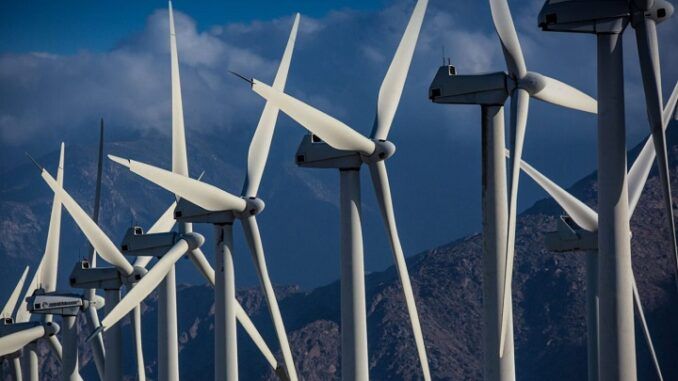
New figures show the pace of China’s clean energy transition is roughly the equivalent of installing five large-scale nuclear power plants worth of renewables every week. It’s installing at least 10 gigawatts of wind and solar generation capacity every fortnight.
Tech Advocate reports:
China, the world’s largest energy consumer, is making rapid strides in its transition to a low-carbon economy. In a bid to reduce its dependence on fossil fuels and mitigate the impact of climate change, the country is installing the equivalent of 5 nuclear power stations’ worth of wind and solar capacity every week. This remarkable feat is being hailed as a major milestone in China’s renewable energy revolution.
According to the National Energy Administration (NEA), China added 53.2 gigawatts (GW) of installed wind power capacity in the first half of 2020, a staggering 14.3% increase from the same period last year. This adds up to a total of over 260 GW of wind power capacity, making China the world’s largest wind power producer. The country is also leading the global charge in solar power, with a total installed capacity of over 200 GW.
The rapid growth in wind and solar capacity is being driven by a combination of government policies, renewable energy targets, and declining Costs. The Chinese government has set a target of generating 35% of its electricity from non-fossil fuels by 2030, and the wind and solar industries are playing a key role in achieving this goal.
China’s wind and solar installations are spread across the country, with provinces like Inner Mongolia, Gansu, and Xinjiang being major hubs for wind and solar power generation. The country’s vast desert regions, in particular, are well-suited for solar power generation, with some of the highest irradiance levels in the world.
The rapid growth in renewable energy capacity is having a significant impact on China’s energy landscape. In 2020, renewable energy accounted for 35% of China’s total power generation, a significant increase from 32% in 2019. Wind and solar power are also helping to reduce greenhouse gas emissions, with emissions from the energy sector declining by 2.5% in 2020.
The rapid growth in wind and solar capacity is also creating new job opportunities and driving economic growth. The renewable energy sector is estimated to support over 3.5 million jobs in China, with the majority of these being in the manufacturing and construction sectors.
While China’s renewable energy surge is a major success story, it is not without its challenges. Integration of wind and solar power into the grid remains a significant challenge, and the country needs to invest in grid infrastructure to ensure a stable and reliable supply of electricity. Additionally, the intermittent nature of renewable energy sources means that energy storage solutions will need to be developed to ensure a smooth transition to a low-carbon economy.
In conclusion, China’s installation of the equivalent of 5 nuclear power stations’ worth of wind and solar capacity every week is a major achievement and a testament to the country’s commitment to renewable energy. As the world’s largest energy consumer, China’s transition to a low-carbon economy is crucial for addressing climate change and ensuring a sustainable future. The country’s renewable energy sector is poised for continued growth as China navigates the challenges of integrating wind and solar power into its energy mix.
CHINA INSTALLING RECORD AMOUNTS OF SOLAR AND WIND, SLOWING NUCLEAR AMBITIONS
ABC News reports:
China is going all in on renewables.
New figures show the pace of its clean energy transition is roughly the equivalent of installing five large-scale nuclear power plants worth of renewables every week. It’s installing at least 10 gigawatts of wind and solar generation capacity every fortnight.
China is building new nuclear plants, although nowhere near as fast as it once intended.
In 2011, Chinese authorities announced fission reactors would become the foundation of the country’s electricity generation system in the next “10 to 20 years”.
But Japan’s 2011 Fukushima disaster prompted a Chinese moratorium on inland nuclear plants, which have to use river water for cooling and are more vulnerable to frequent flooding.
Meanwhile, over the following decade, solar became the cheapest electricity in the world. From 2010 to 2020, the installed cost of utility-scale solar PV declined by 81 per cent on a global average basis.
As well as cheap, it was safe, which made solar farms quicker to build than nuclear reactors. Instead of nuclear, solar is now intended to be the foundation of China’s new electricity generation system.
Authorities have steadily downgraded plans for nuclear to dominate China’s energy generation. At present, the goal is 18 per cent of generation by 2060.
China installed 1GW of nuclear last year, compared to 300GW of solar and wind.

The need for space has led China to experiment with floating solar farms, like this one in Huainan, Anhui province.
Sources:
- The Tech Advocate, July 17, 2024. https://www.thetechedvocate.org/china-installing-the-wind-solar-equivalent-of-5-nuclear-power-stations-a-week/
- ABC News – Science, 16 Jul 2024. https://www.abc.net.au/news/science/2024-07-16/chinas-renewable-energy-boom-breaks-records/104086640